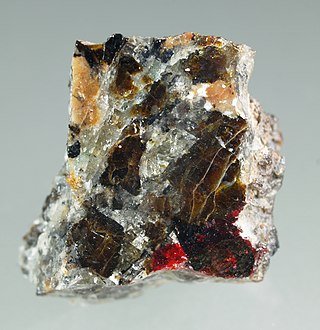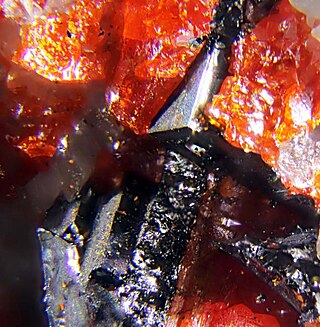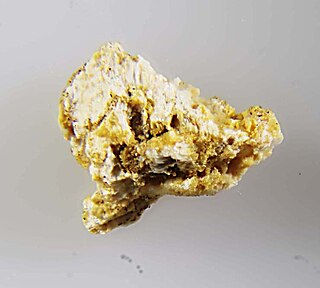Related Research Articles
Grossite is a calcium aluminium oxide mineral with formula CaAl4O7. It is a colorless to white vitreous mineral which crystallizes in the monoclinic crystal system.
Aradite is a very rare mineral with formula BaCa6[(SiO4)(VO4)](VO4)2F. Aradite and its phosphorus-analogue, zadovite, were found in paralavas (rocks formed due to pyrometamorphism) of the Hatrurim Formation. Both aradite and zadovite have structures similar to that of nabimusaite. Structure of all three minerals is related to that of hatrurite.
Zadovite is an extremely rare mineral with formula BaCa6[(SiO4)(PO4)](PO4)2F. Together with its vanadium-analogue, aradite, zadovite occur in paralavas (type of pyrometamorphic rocks). Both minerals have structures similar to nabimusaite, and these three minerals occur in the Hatrurim Formation of Israel. Structure of all three minerals is related to that of hatrurite. Minerals combining barium, phosphorus and silicon together are scarce.
Nabimusaite is a very rare mineral with formula KCa12(SiO4)4(SO4)2O2F. Its structure, as in case of similar aradite and zadovite, is a derivative of the one of hatrurite. Nabimusaite gives its name to the nabimusaite group. The mineral was found in a pyrometamorphic rock of the Hatrurim Formation, a site known for the natural pyrometamorphism. It is interpreted to have formed due to interaction of a precursor assemblage with sulfate-rich melt. Nabimusaite is potassium- and fluorine-analogue of dargaite.

Gurimite is a rare mineral with formula Ba3(VO4)2. It is a simple barium vanadate, one of the most simple barium minerals known. It is named after its type locality - Gurim anticline in Israel. It has formed in the rocks of the Hatrurim Formation. Gurimite's stoichiometry is similar to that of copper vanadates mcbirneyite and pseudolyonsite. An example of other barium vanadate mineral is tokyoite.
Feodosiyite is a very rare chloride mineral, just recently approved, with the formula Cu11Mg2Cl18(OH)8•16H2O. Its structure is unique. Feodosiyite comes from the Tolbachik volcano, famous for many rare fumarolic minerals. Chemically similar minerals, chlorides containing both copper and magnesium, include haydeeite, paratacamite-(Mg) and tondiite.

Hendekasartorite is a very rare thallium sulfosalt mineral with formula Tl2Pb48As82S172. It is one of recently approved new members of sartorite homologous series, by enneasartorite and heptasartorite. All new members come from Lengenbach quarry in Switzerland, prolific in terms of thallium sulfosalt minerals. Hendekasartorite is chemically similar to edenharterite and hutchinsonite.

Fluorwavellite is a rare phosphate mineral with formula Al3(PO4)2(OH)2F•5H2O. As suggested by its name, it is a fluorine-analogue of wavellite (hence its name), a rather common phosphate mineral. Chemically similar aluminium fluoride phosphate minerals include fluellite, kingite and mitryaevaite.

Steinmetzite is a very rare phosphate mineral with formula Zn2Fe(PO4)2(OH)•3H2O. It was discovered among pegmatites of Hagendorf in Germany, that are famous for rare phosphate minerals. Steinmetzite is chemically related to phosphophyllite and other zinc iron phosphates, namely plimerite and zinclipscombite.
Hydroterskite is a rare zirconium silicate mineral, related to terskite (hence its name), with the formula Na2ZrSi6O12(OH)6. It was discovered in the Saint-Amable sill near Montréal, Québec, Canada. It is hydrous, when compared to terskite. Chemically similar minerals include litvinskite and kapustinite.
Ilirneyite is a rare tellurate mineral with the formula Mg0.5[ZnMn3+(TeO3)3]•4.5H2O. It was discovered at the Sentyabr'skoe deposit (of silver and gold) in the Ilirney Range, Western Chukotka, Russia.
Itelmenite is a rare sulfate mineral with the formula MnCr2S4. It was discovered in Social Circle meteorite found in Georgia, US.
Hermannjahnite is a rare sulfate mineral with the relatively simple formula CuZn(SO4)2. It is one of many fumarolic minerals discovered on the Tolbachik volcano.
Manganiceladonite is a rare silicate mineral with the formula KMgMn3+Si4O10(OH)2. It is one of many minerals discovered in the Cerchiara mine, La Spezia, Liguria, Italy.
Kainotropite is a rare vanadate mineral with the formula Cu4FeO2(V2O7)(VO4). It contains trivalent iron. It is one of many fumarolic minerals discovered on the Tolbachik volcano. The name of its parental fumarole is "Yadovitaya", which means poisonous.
Wiklundite is a rare and complex arsenite-silicate mineral with the chemical formula Pb2(Mn2+,Zn)3(Fe3+,Mn2+)2(Mn2+,Mg)19(As3+O3)2(Si,As5+O4)6(OH)18Cl6. The mineral characterizes in a large c unit cell parameter. It was found in Långban, Sweden - a home for many rare and exotic minerals.

Shumwayite is a rare but relatively simple uranyl sulfate mineral with the formula (UO2)2(SO4)2•5H2O. It was discovered in the Green Lizard and Giveaway-Simplot mines of the White Canyon mining district, San Juan County, Utah, US.
Charleshatchettite is a very rare, complex, niobium oxide mineral with the formula CaNb4O10(OH)2•8H2O. It was discovered in the mineral-rich site Mont Saint-Hilaire, Montérégie, Québec, Canada.
Plavnoite is a rare complex uranium sulfate mineral with the formula K0.8Mn0.6[(UO2)2O2(SO4)]•3.5H2O. Typically for the secondary uranium mineral, plavnoite contains uranyl groups. It was discovered in the Plavno mine in Jáchymov, Czech Republic. The Jáchymov site is known as a type locality for many rare and unique minerals.
Wampenite is a rare organic mineral with the formula C18H16, found in Wampen, Fichtelgebirge, Bavaria, Germany.
References
- ↑ Warr, L.N. (2021). "IMA–CNMNC approved mineral symbols". Mineralogical Magazine. 85 (3): 291–320. Bibcode:2021MinM...85..291W. doi: 10.1180/mgm.2021.43 . S2CID 235729616.
- 1 2 Galuskina, I.O., Galuskin, E.V., Prusik, K., Vapnik, Y., Dzierżanowski, P., and Murashko, M., 2015. Hexacelsian, IMA2015-045. CNMNC Newsletter No. 27, October 2015, 1224; Mineralogical Magazine 79, 1229–1236
- 1 2 "Cymrite: Cymrite mineral information and data". Mindat.org. Retrieved 2016-03-12.
- ↑ "Hatrurim (Hatrurim Basin), Negev, Israel - Mindat.org". Mindat.org. Retrieved 2016-03-12.
- ↑ "Celsian: Celsian mineral information and data". Mindat.org. Retrieved 2016-03-12.